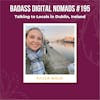International Travel, Medical, and Health Insurance Explained

What type of travel insurance should you get? Kristin explains the different types of trip insurance, what's covered, prices, and more. You get an overview of travel insurance options, credit card insurance, and learn the benefits of buying an insurance policy in advance. She also offers options for supplemental insurance to protect your technology equipment and how to get extra coverage for adventure travel and action sports. At the end of this episode, she compares and contrasts international versus local health insurance plans.
What type of travel insurance should you get? Kristin explains the different types of trip insurance, what's covered, prices, and more. You get an overview of travel insurance options, credit card insurance, and learn the benefits of buying an insurance policy in advance. She also offers options for supplemental insurance to protect your technology equipment and how to get extra coverage for adventure travel and action sports. At the end of this episode, she compares and contrasts international versus local health insurance plans.
Episode 161 Special Offers:
Travel Insurance Resources Mentioned:
- Allianz Executive Insurance
- American Express Travel Insurance
- Chase Sapphire Preferred Card
- Chase Sapphire Reserve Card
- Diplomat Adventure Sports Insurance
- Insure My Trip Marketplace
- Medjet Assist
- SafetyWing
- Sagicor Costa Rica Tourist Insurance
- Trawick Adventure Travel Plans
- World Nomads
Technology Insurance:
International Health Insurance:
- Aetna International
- Cigna Global Expat Insurance
- GeoBlue International
- IMG Global (Travel and Health Insurance)
- Pacific Prime
Related Badass Digital Nomads Podcast Episodes:
...........................................................................................
Connect with Kristin:
- Follow on Instagram
- Subscribe to Traveling with Kristin on YouTube
- Subscribe to Digital Nomad TV on YouTube
- Join the Badass Digital Nomads Facebook Group
...........................................................................................
Support the Badass Digital Nomads Podcast:
- Buy Kristin a Coffee
- Become a Patron
- Leave a 5-Star Review
- Buy Official Merch
- www.badassdigitalnomads.com
...........................................................................................
A special thank you to Kristin's Patrons!
Warm welcome to new patrons, Em Winn, Daniel Sullivan, and Dion!
Become a Patron for $5/month at Patreon.com/travelingwithkristin
...........................................................................................
Podcast descriptions may contain affiliate links of products and services we use and recommend at no additional cost to you.
Introduction: Welcome to Badass Digital Nomads, where we're pushing the boundaries of remote work and travel, all while staying grounded with a little bit of old school philosophy, self-development, and business advice from our guests.
Kristin Wilson, Host: Hello there, Kristin, fromTraveling with Kristin here and welcome to episode 161 of Badass Digital Nomads. Today let's talk about travel insurance and specifically where to find travel insurance. What is the best travel insurance to get and how is it different from health insurance? This is probably a topic that we could do multiple episodes about, so I'll cover some of the basics in today's episode and then we'll continue the conversation over in the Badass Digital Nomads Facebook group. If you guys have more questions, we can always do another follow up episode with more information. As usual, we'll have all of the resources in the show notes. And full disclosure, I am an affiliate of Safety Wing. I've had the founder on the podcast before. We'll link to the interview with him as well. And so you can use my referral link if you do end up purchasing insurance through Safety Wing, but we're going to talk about a lot of different companies and providers of travel insurance on the show today.
I also have a whole section on travel and international health insurance in my book Digital Nomads for Dummies. So you can pre-order your copy today, also linked in the show notes, or you can find it on Amazon, Barnes and Noble, Target, Walmart. So a big question that people have is, you know, should you get travel insurance at all? And then should you just use the travel insurance that comes on your credit card or should you buy a separate policy? I have always had some form of travel insurance ever since I was traveling as a teenager and studying abroad in college, even if you never use it, if you ever had to or if something major happened, I mean it can be really expensive and accidents aren't planned, so there's no way to foresee if you'll use it in the future or to really completely protect yourself against things that might happen when you're traveling.
So I think it's always a good idea to have it. And I have used mine so many times. I've used it for getting stitches in Costa Rica. I used it to get a rabies vaccine when I had a little interaction situation with a bat and I had to fly from Noosara, Costa Rica to San Jose to get the rabies vaccine just in case I got really sick at an all-inclusive resort once in Dominican Republic and I end up in the emergency room multiple days. When I got back to Costa Rica, I sprained my ankle once in Prague. I've had snowboarding accidents in Japan, had trips canceled because airlines went out of business. I mean all sorts of things. The big difference between emergency travel, medical insurance and regular health insurance is that travel insurance is going to cover you for things like trip cancellation, trip interruption, delays, lost or stolen baggage, emergency medical situations, accidents, things like that.
And then health insurance is what covers you for pre-existing conditions. So if you're traveling short term and just going on vacation, you'll want to keep your home country health insurance coverage and just get some sort of travel or trip insurance for your trip. And the good thing about travel insurance is that it can cover you on your trip, but it can also cover you before you leave. So many companies like Safety Wing and World Nomads will allow you to purchase a travel insurance policy while you're already traveling. But the benefit of buying it before you leave is that it can cover you for something that happens before your trip. So once my mom and I had planned this trip to Italy and Romania and we were going to a few different countries, but she actually fell while jogging one day and we had to cancel our whole trip.
So fortunately my mom had purchased travel insurance before when we booked our trip. And so because we had to cancel for a medical reason, we were able to get reimbursed for any cost related to canceling our trip. So unfortunately we never went to Sicily or Romania together, but that's one of the benefits of purchasing a policy when you book your trip because if you book it months in advance, then you can be covered for something that happens leading up to your departure date. So it's nice to have that coverage leading up to your trip and then for anything that might happen from the time of departure. So I recently went to Canada and my flight was delayed all day and then finally canceled. And so that was something that I could claim on my travel insurance, which I had coverage with Safety Wing. And when comparing and contrasting plans and before you choose one, you just wanna look really closely to see what's covered and what the amounts are and choose your plan based on that.
And so some of the things that you can expect coverage for in a typical trip insurance or travel insurance plan is, as I mentioned, that trip cancellation for anything that you would need to cancel your trip for before it even starts, whether it's getting sick unexpectedly or having an accident before your trip, some sort of adverse weather conditions or even an unexpected job termination could be covered as well. Then you've got the trip interruption once you're actually on your trip. Medical emergency medical coverage, and sometimes emergency dental coverage while you're on the trip. One time when I was living in Nicaragua, I met this guy who came there on a surf trip and he was just starting this one year trip of traveling throughout Latin America and the poor guy, he got hit with his surfboard on the first morning that he was there and he had to get his jaw wired shut and it was just so sad because he had to stay in Nicaragua for quite some time to be able to heal up and then he had to cancel the rest of his trip.
So you've got your emergency medical dental coverage and then depending on the type of travel that you're doing, you might want to get a supplemental insurance plan to cover any sort of extreme sports. So I'll talk about a couple of options for that at the end. So you've got the trip cancellation and interruption, you've got the emergency medical coverage, also evacuation and repatriation, and there's also extra supplemental coverage you can get for that. There are companies like Medjet that have this membership where you can get extra coverage for air Medical transport services on a monthly or annual basis. Hopefully you never need to use it and something like medical evacuation can run into the six figures. And so Medjet could be good if you don't want any sort of limits or restrictions on the amount of the claim that you're making. I've seen some people getting in scooter or moped accidents in places like Bali or Southeast Asia and I've seen them putting crowdfunding pages to cover extra medical expenses.
So this could work in a situation like that. And that sort of plan for an individual annual plan, international and domestic with medical transfer security and crisis response would cost around $800 per year. And they also have an option for members between ages of 75 and 84. So sometimes people ask me for insurance options if you're over a certain age and this would be one of those supplemental options. Also, typically included in travel insurance policies are accident protection or coverage in case of death or dismemberment. And you can get pretty high policies there from up to a hundred thousand dollars, $500,000. I've even seen policies up to a million dollars. And then most travel insurance companies will also cover you for lost or delayed baggage and it just depends how many hours they consider a delay. Some companies are up to just a couple hundred dollars and some of them can be up to $3,000 for a bag.
And then you can also get trip delay insurance, which is reimbursement for in case your travels are delayed. So overbooked flights, missed connections. And then most travel insurance companies also have a 24 hour emergency hotline. So you can call them with any questions that you have. You can get referrals to doctors and sometimes that's either on the phone, but you can also do it logged into your portal. For example, if you're using Safety Wing, if you're going to be booking your entire trip on one credit card, then you could consider just using your credit card insurance. If you have a travel credit card like the Chase Sapphire Reserve card, they have pretty good trip insurance coverage. I've seen that the travel credit cards, like the general credit cards seem to have better policies compared to the specific airline cards. So if you get like a United Card Delta card, an American Airlines cards, those typically seem to have slimmer coverage compared to the platinum credit cards or the specific travel cards.
The Chase Sapphire card can have up to $10,000 coverage for trip cancellation, $3,000 for lost luggage and they also have rental car insurance. And even though I book all of my travel using credit cards, I still like to have a monthly or annual plan just in case because there can be a lot of fine print and sometimes when you go to make a claim you can find out that certain things that you thought were covered weren't covered. So it's always important to read those policies in advance and you might even want to make this decision on a case by case basis. So if you're traveling year round as a nomad, I think it's always good to have an international plan that can cover you in multiple countries. And you know, sometimes you're using different cards to book different things, but it really depends on the length of your trip and also what type of coverage you want.
So travel insurance can have some limitations and shortcomings, especially when it comes to extreme sports or dangerous activities. And also for protecting your electronics. So you might have limits of $500, a thousand dollars, $2,000 to protect your electronics and valuables. And you know, one MacBook Pro could cost four or $5,000. So in that case you might wanna look into some extra supplemental electronics insurance and one that I've used for a long time is ppa, which is the Professional Photographer's Association of America. So depending on what country you're from, look for a photography association insurance option if you want to cover electronics like your laptop camera, gear, drone, things like that. And with the PPA, they have a monthly membership that's around $30 per month, but then you can also get an extra insurance plan. So they have their regular membership and then they have this photo care or photo care plus coverage that can give you up to a hundred thousand dollars in coverage.
So if you're traveling with a lot of professional equipment, that can be a really good idea. And with these sorts of supplemental insurance plans, you need to actually ensure each item specifically. So you need to register the items that you want to get coverage for in advance. The PPAs annual Photo Care plus coverage starts at $175 per year. That's gonna cover your hardware, it's gonna cover you in case of theft, including if it's in a car, drone coverage in case you're crashing your drone. And I had my brother once had his Pelican cases, so his camera equipment cases completely emptied out on an American Airlines flight, I think it was to Puerto Rico. So he had checked his camera equipment and all of it was stolen. So he picked up his bags at the baggage care cell and they were empty. And luckily he had equipment insurance that covered pretty much everything, but that sort of equipment can be tens of thousands of dollars.
And you can also even get coverage for lost data as well. And even if you're not traveling when you purchase hard drives or anything like that, you can even opt into getting an insurance plan for one year, two years, three years when you buy your actual equipment. So I usually don't get that because then I just have multiple insurance plans to keep track of. But I do like to have a comprehensive plan through the PPA when I'm traveling internationally. There's also a website called insuremyequipment.com, and they have six month policies starting at $320, an annual policy starting at $470. And as I mentioned, another type of supplemental insurance that you might wanna get is for extreme sports. There's a plan called Diplomat International Sports Travel Insurance that can give you up to a million dollars in adventure sports insurance. There's also a plan called the Trawick Safe Tracker, Extreme Sports Insurance, and that can cover you for up to 180 day length of trips for extreme and adventure and action sports.
I pulled a quote for the Diplomat International Plan and it came out to $246 for one month. World Nomads also has a standard plan and an explorer plan in the explorer plan can cover some additional adventure sports and activities, but some are flat out excluded, like base jumping, so anything that's really risky might be excluded altogether from those policies. Surprisingly, bull riding is covered by the explorer plan, but bungee jumping is covered by the standard plan. Camping over a certain elevation, you might need different coverage up to 6,000 meters is covered under the standard plan and 7,000 meters in the Explorer plan. Scuba diving and shallow water can be covered by the standard plan, but cave diving or diving at a certain depth, you would need that extra explorer coverage. Also for different types of skiing and snowboarding on peace or back country, you might need different plans for that.
Some other major things that aren't typically covered in travel insurance are acts of war accidents while intoxicated and preexisting conditions. So for pre-existing conditions, if you want coverage while traveling in a foreign country, you would need to get an international health insurance plan. Another question you might have is about Covid and these days it looks like most travel insurance providers are including Covid coverage for in case you get Covid before you leave and you have to cancel your trip or if you contract it while traveling. But the only thing that they seem to point out is that you can't get coverage from canceling due to fear of covid or if you feel uncomfortable about traveling during covid, that would be more preventative, it wouldn't cover that, but it would cover it if you up to a certain amount, right, if you were to get covid while traveling.
And some companies cover quarantining expenses while others only cover medical expenses. So just make sure to read your plan before buying it. And then with pre-existing conditions, that's usually not covered, but you can search online for supplemental travel insurance for pre-existing conditions or if you're going to be a broad long term then you could get an international plan. Now I pulled up a few different prices just for comparison's sake so you can get an idea of how much it might cost. I put in a trip for one month to Mexico for a person average age of 40 residing in the United States. And for Safety Wing I got a quote of $46 and 50 cents for the month. For World Nomads I found quotes ranging from $105 for the standard plan up to $187 for the Explorer plan. American Express also has travel insurance coverage that you can get whether or not you're a cardholder.
And on Amex's website I found plans ranging from $59 for their basic coverage, which is pretty slim coverage to be honest, up to $288 for their premium gold plan. Another marketplace where you can compare and contrast plans from different providers including Allianz and IMG is insuremytrip.com and there I used to use them all the time, but it looks like it was a bit more expensive with plans ranging from $154 up to nearly $400 for one month. And there's also the option to get tourist insurance in your destination country. So that's an option if you are planning on traveling to just one country. Whereas with the other plans you can put in your first destination, but it will usually cover you for multiple countries. And so an example of this would be in Costa Rica they have this individual insurance for tourists through INS or also through Sagicor.
And I put in a quote for just 30 days with Sagicor and it came out to $309. So that's pretty expensive. It's basically double the price or more of the other options that I just mentioned. And the coverage is a bit lower, so medical expenses are covered up to $20,000, whereas with a Safety Wing plan it's up to to $250,000. The other drawback of buying an individual policy in the country that you're going to is that it's probably not going to cover you for that trip cancellation leading up to your date of departure or en route to the country. So it's probably only gonna cover you once you arrive there. And then just for comparison sake, that Extreme Sport supplemental insurance around $250 per month and then that electronics coverage can be a few hundred dollars per year. One of the things that I usually avoid is taking the box to add insurance when I'm buying a flight because usually that's pretty expensive and has a lot of fine print.
I just personally feel more comfortable getting a dedicated insurance plan instead of just adding something to my plane ticket. And in the case of getting international health insurance, so everything we've talked about today so far is just related to travel, medical insurance or trip insurance, but if you wanted international healthcare coverage, think that's something we should talk about in a separate episode. But basically if you're going to be traveling long term full time and you don't expect to return to your home country to get your regular annual insurance coverage, then you would want to get either a policy that will cover you in the country that you're moving to or an international health insurance policy that can cover you in multiple countries. So there have been years in the past where I kept my US health insurance because I was going to be going back and forth to the US and I could book my annual checkups or physicals for when I was in the us but there have also been other years where I wasn't going back to the US at all.
And so I would get an international health insurance plan that covered me abroad. Now sometimes the emergency medical insurance plans like with Safety Wing's Nomad Insurance, if you're going to be getting a plan of at least 90 days, then you can start to generate emergency medical coverage for your home country up to 15 days or 30 days. So that's not for preexisting conditions, but that's for if you are living internationally and then you come back for a visit and something happens, maybe a car accident when you're back visiting home, you could be covered for that emergency medical coverage. So that's a bonus as well. But for international healthcare, I used to pay out of pocket for, for things like a annual checkup in Costa Rica, it might cost me $50 or so and I'd even pay for testing and lab work just paying out of pocket.
Maybe it would cost $70 or $80, which is a drop in the bucket compared to what it would cost me to pay out of pocket in the us. But that was when I was really young, you know, in my twenties. So I wasn't anticipating to have to pay for any sort of recurring care. It would just be, okay, pay $40 for this dentist appointment and you know, dental cleaning or $50 for this physical or checkup. And even sometimes specialist doctors can be quite affordable being out of pocket in different countries. But for peace of mind, you could go with an international expat insurance policy and some of the companies that you can check for those types of plans include Cigna, IMG, Pacific Prime, Allianz, Aetna, Safety Wing as well has their remote health insurance. And this is going to cover you for preexisting conditions, for preventative care, for surgery, for telemedicine, dental coverage, and a lot of these expat insurance plans are gonna run you around a few hundred dollars per month.
I just looked up a quick plan with a company called GeoBlue and it comes out to 375 per month. Safety Wing also has their remote health insurance for remote employees and they also have one coming soon for remote workers and nomads that starts at $206 per month for people between 18 and 39. The prices go up with age, so it's starting around $300 per month for 40 to 49 for 90 per month for ages 50 to 59 and close to $920 per month for ages 60 to 69. But that's with worldwide coverage with some exclusions. Just like with those tourist insurance plans, you can also choose to get a private health insurance plan in your destination country, especially if you're going to be living there for a long time. Now sometimes that can be included or as an add-on if you're getting a residency status in a certain country.
So you'll really only need to get an international health insurance plan if you're going to be traveling long-term through multiple countries. Otherwise you could always opt to go back to your home country to get care or you can get a private insurance plan in a single destination. So if you are moving to Mexico long term, you can get, get a local health insurance policy with a Mexican insurance company, or if you're traveling to Spain or Portugal, you can get a plan with a local company there. You can also get an international plan as well. So I hope that helps you get a good overview of the different types of insurance options that you have, some of the pros and cons and different sorts of coverage that you can get while traveling. I'll link to all of the companies mentioned today in the show notes. And just to give you another overview, again, you have your international emergency medical trip insurance option, you have international or local global health insurance option.
You have supplemental insurance options for either rental cars, for covering your electronics and camera equipment, for covering your data plans, and also for covering you for Extreme or adventure sports.
I definitely recommend looking up policies with a few different companies to compare and contrast coverage and choose the plan that's best for you. As you found in this episode, the prices can vary widely from $50 per month to $500 per month or more. So make sure to do your research and you can also opt for using your credit card insurance if you have a platinum card or a travel insurance credit card. But just make sure to read the policy and call your provider before deciding which one to use. And it's always a good idea to get that extra coverage just in case.
If you have any questions about how to choose a travel insurance plan, I will create a post in the Badass Digital Nomads Facebook group. We can continue the conversation over there and if we get a lot of FAQs in the comments, I'll do a follow up episode here on the podcast. Have a great week and stay tuned for more because we have a lot of great interviews on that coming for you in the upcoming months, starting next week.































































